6 Best Goblet Squat Variations (with Pictures!)
Goblet squats are known for being both versatile and easy on parts of the body that are normally taxed when doing other heavy leg exercises.
These two defining benefits make it a classic among functional athletes and individuals that dislike the classic back squat.
However, it doesn’t quite stop there. Even for those that dislike the conventional goblet squat, there are several variations that build upon its main advantages - taking them and adding a new spin to further benefit the lifter.
Although it is best to first master the regular goblet squat when new to lifting, we recommend trying out variations like the goblet Bulgarian split squat or the goblet box squat. Both bring a fresh take on the classic goblet squat while also helping target different parts of the lower body.
What are Goblet Squats?
To put it in detail, goblet squats can be described as closed chain compound exercises featuring marked use of hip and knee flexion to train the lower body.
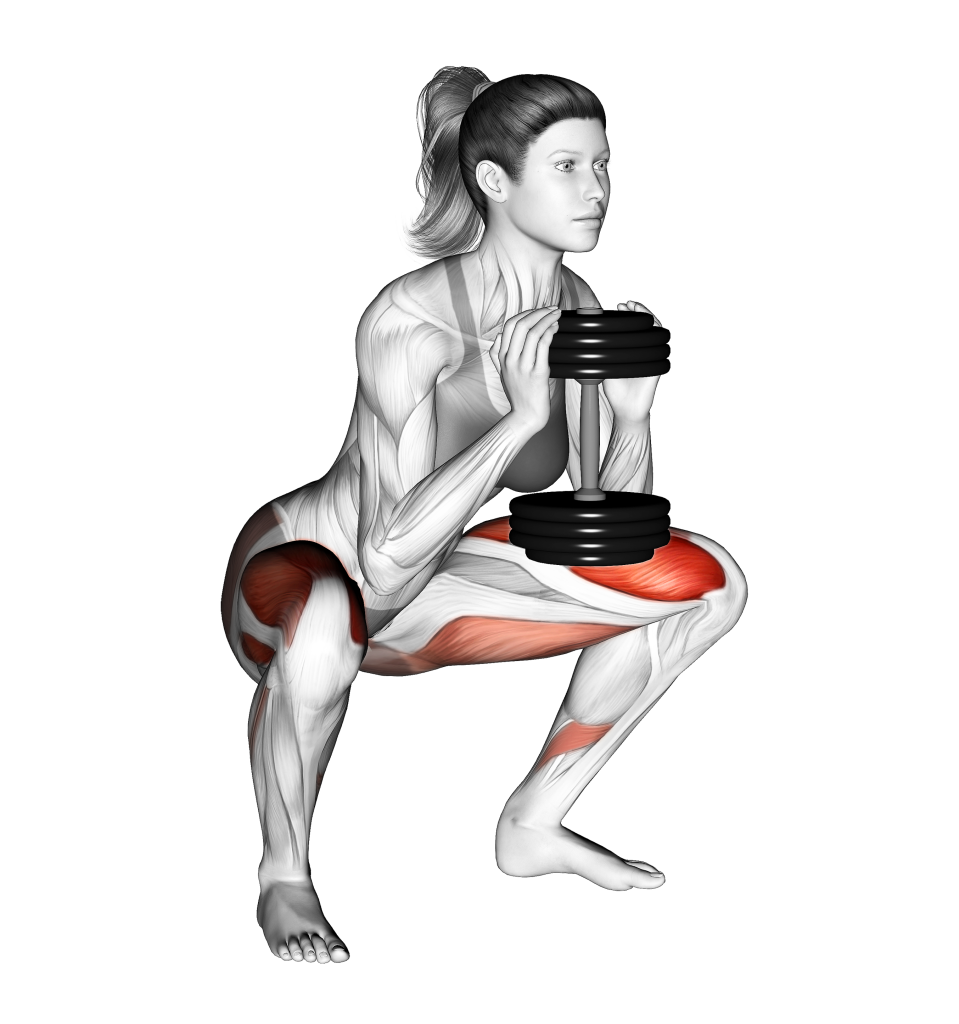
While goblet squats are often compared to the more popular back squat due to their similarity, goblet squats feature the lifter gripping a kettlebell or dumbbell in both hands at chest level - hence the name “goblet” squat, as it appears like they are holding a goblet.
Apart from this manner of gripping the weights, the general goblet stance is also somewhat more vertical in regards to the torso. This is the reason behind the fact that practically all goblet squat variations avoid placing stress on the back and spine.
The majority of these variations alter the larger movement pattern of the exercise, but nearly all will feature the same goblet method of gripping a dumbbell or kettlebell.
Are Dumbbells or Kettlebells Better for Goblet Squats?
Both dumbbells and kettlebells are used in the same way when performing goblet squat variations.
However, depending on the size of your hands and how heavy you are lifting, it may be preferable to pick a kettlebell over a dumbbell. This is simply because - after a certain incremental amount of weight - dumbbells become too large to reliably hold for the average person.
Kettlebells feature a U-shaped handle atop the weight, and as such do not suffer from the same disadvantages.
Goblet Squat Variations
1. The Conventional Goblet Squat
The conventional goblet squat is simply the regular form of goblet squat, with a hip-width stance, bilateral movement pattern and an equally distributed recruitment of the lower body’s musculature.
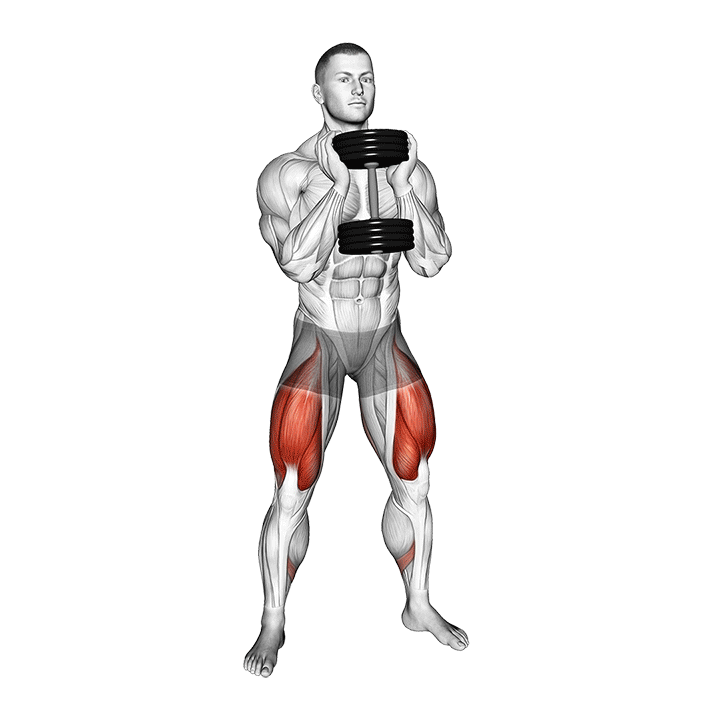
Regular goblet squats are most often performed with the intention of building strength, mass and athleticism in the leg muscles. It is frequently used as an alternative to the back squat for individuals who wish to avoid loading the spine, or as an accessory movement as a part of an athletic training drill.
Apart from being compared to the back squat, the goblet squat is occasionally also compared to the front squat due to their similar placement of weights at the front of the torso.
While the two exercises place the weights within inches of the same spot, the goblet squat features a slightly more forward position, rather than placing a barbell atop the chest shelf. This leads to somewhat greater quadriceps recruitment and less difficulty maintaining the correct stance.
Muscles Worked
Conventional goblet squats prioritize the quadriceps, but also target the glutes and hamstrings as well. In addition, the deltoids and core are both worked in an isometric capacity.
Defining Benefits as a Variation of Goblet Squat
Apart from being quite forgiving on the back and spine, goblet squats are also known for being an excellent method of building quadriceps mass and strength.
This is partly on account of its more forward angle of resistance, but also because its inherently limited load allows for greater volume to be used.
How-to:
To perform a conventional goblet squat, the lifter will begin by setting their feet hip-width apart, toes pointed forwards and spine stacked in a neutral orientation.
A dumbbell or kettlebell should be held at chest level in both hands, palms facing towards one another.

From this stance, the lifter will brace their core, fix their eyes and head forwards and push their pelvis back.
As they sit back with their hips, the knees should also bend, allowing the lifter to lower themselves until their hips are at least parallel with the top of the knees.
Once reaching this depth, the lifter then drives through their feet and extends their knees and hips - rising into a standing position and thereby completing the repetition.
Depending on the equipment used and the lifter's proportions, the elbows may limit how far down the lifter can squat by touching the tops of the thighs. It is up to the lifter whether they should account for this by widening their stance or not.
2. The Heel-Elevated Goblet Squat
The heel-elevated goblet squat is exactly as it sounds; a conventional goblet squat performed with the heels raised higher off the ground.
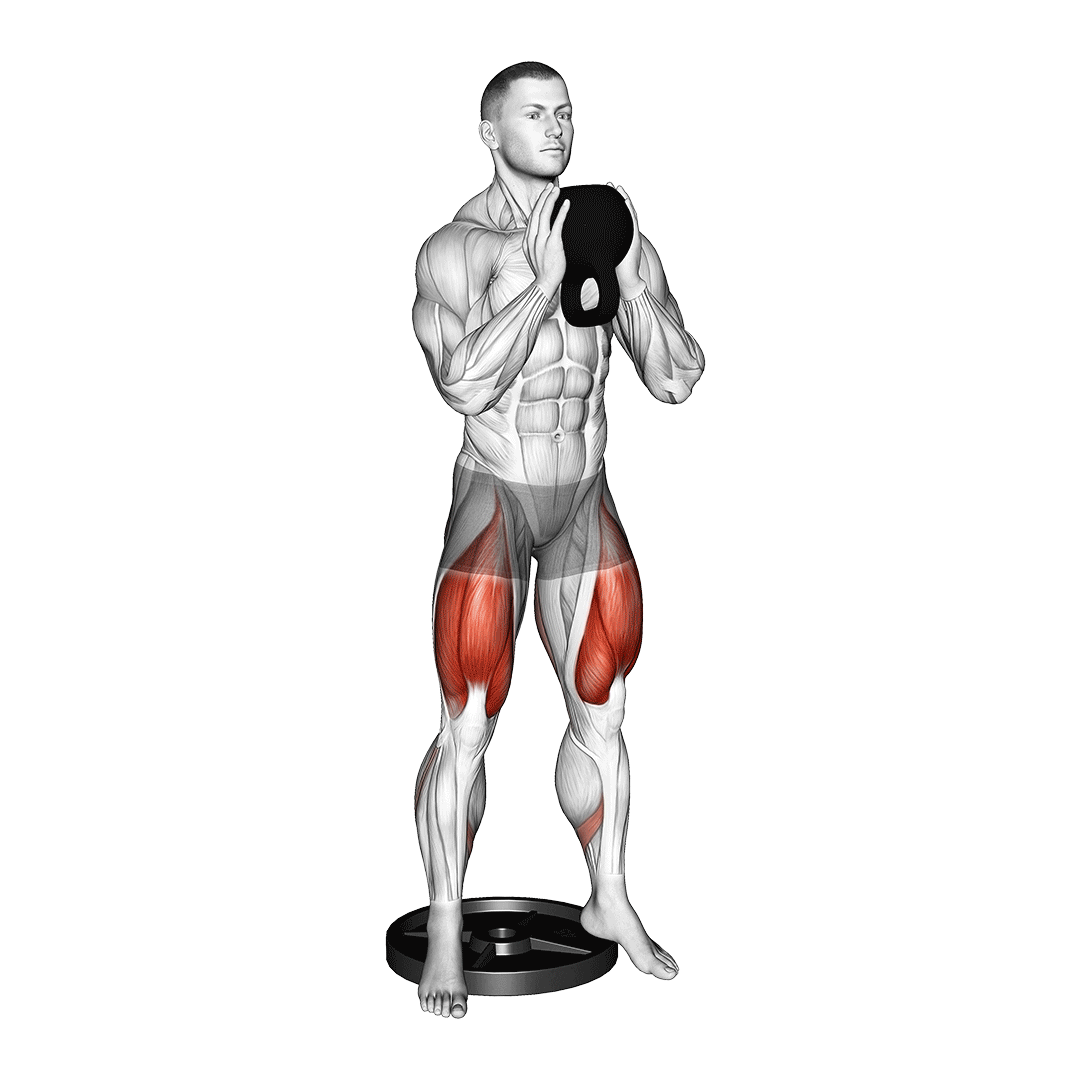
This creates an even more forward tilt to the entire lift, further emphasizing the quadriceps and shifting more stress away from the back. However, this will also shift more stress towards the knees, forcing the knees to track over the toes and requiring greater care be taken.
Otherwise, the exercise remains much the same as its conventional variation, including stance-width, anterior load positioning and general usage of knee and hip mechanics.
Muscles Worked
Because the heels are elevated off the ground, this particular variant emphasizes the quadriceps to a greater degree and range. In turn, even less emphasis is placed on the glutes and hamstrings than with its conventional cousin.
Of course, mobilizers aside, the heel-elevated goblet squat also recruits the deltoids and abdominals as stabilizers.
Defining Benefits as a Variation of Goblet Squat
Heel-elevated goblet squats are defined by their more forward stance, maximizing quadriceps development and further reducing strain of the back.
Apart from this, elevation of the heels can also aid individuals who have trouble reaching proper squat depth due to poor ankle mobility.
How-to:
To perform a repetition of the heel-elevated goblet squat, the lifter will place a weight plate on the floor, setting their heels atop it slightly less than hip-width apart. A dumbbell or kettlebell should be gripped at chest height in the usual goblet stance.
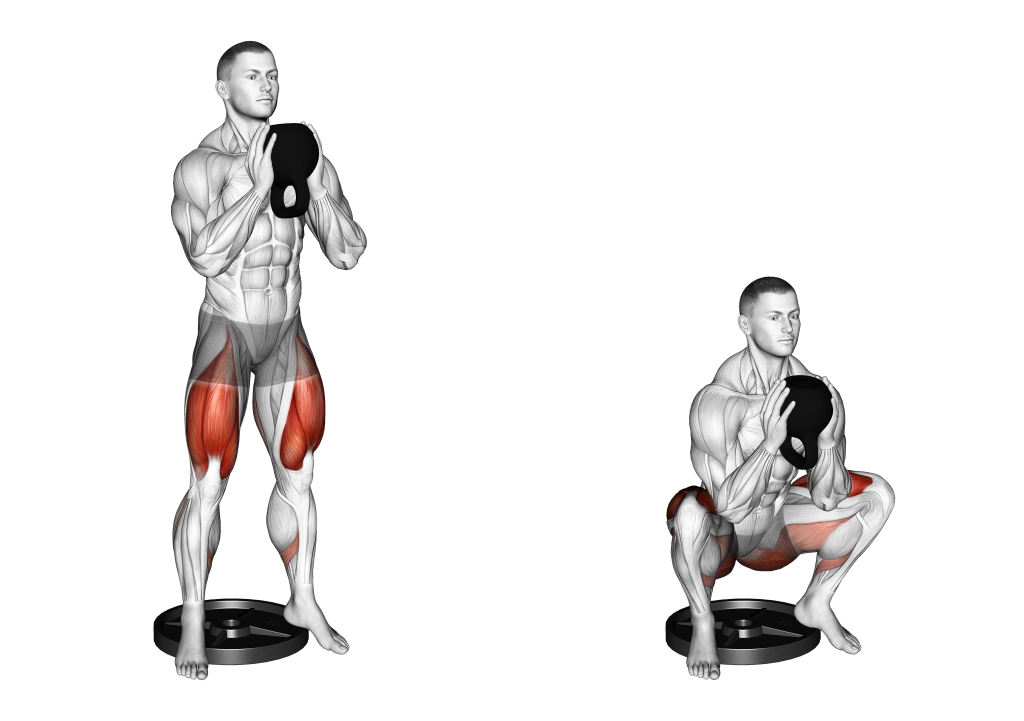
Once the heels are positioned atop the elevated platform, the lifter will push their pelvis back and bend at the knees, taking care to keep the knees aligned in the same direction as the toes.
When the hip crease is at least parallel with the tops of the knees, the lifter then drives through their forefeet and rises back to a standing position.
As always, remember to pay extra attention to keeping the chest upright and the torso vertical as this exercise is performed.
3. The Sumo Goblet Squat
Sumo goblet squats are a variation that allows the lifter to assume a somewhat more narrow stance.
Widening the distance of the feet in this way has quite a few benefits, ranging from being more compatible with certain bodily proportions to a shorter range of motion.
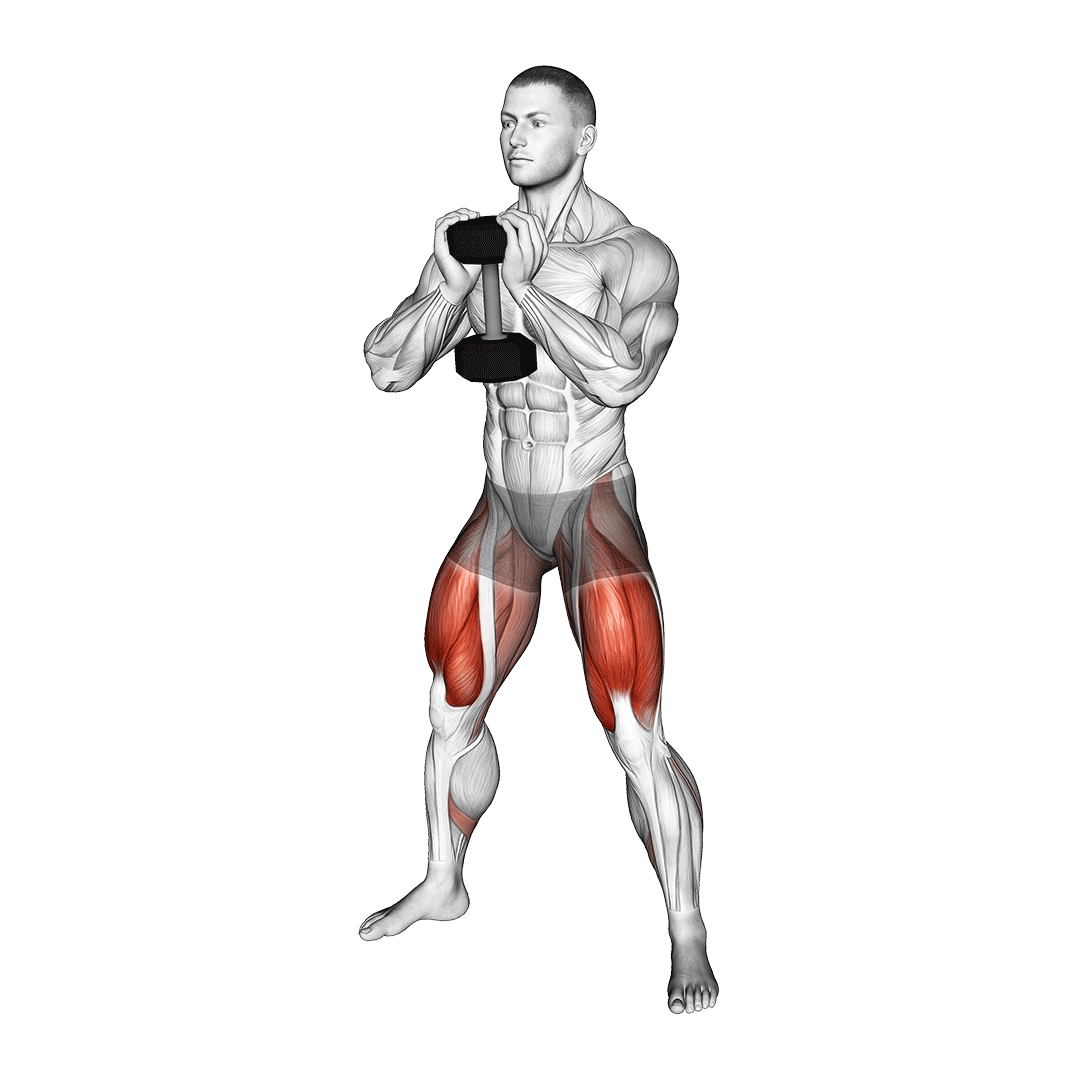
Because the sumo goblet squat is stanced in such a way, less emphasis is placed on the quadriceps, instead shifting more of the load to the posterior chain.
Apart from a wider stance and somewhat more outward knee tracking angle, the sumo goblet squat is otherwise mechanically similar to conventional goblet squats. More advanced lifters may wish to take advantage of its greater loading capacity to boost their workout.
Muscles Worked
Sumo goblet squats emphasize the posterior chain and hip adductors, but will also target the quadriceps to a measured degree as well.
Defining Benefits as a Variation of Goblet Squat
Apart from targeting the adductor muscles and placing greater emphasis on the posterior chain, the sumo goblet squat is also quite effective for maximizing loading capacity or volume. This is on account of its shorter range of motion, allowing less exertion to be spent with each repetition.
Sumo goblet squats are also occasionally used by strength athletes to correct issues with conventional back squat depth without the risk of straining the lower back.
How-to:
To perform a repetition of the sumo goblet squat, the lifter will set their feet wider than hip-width apart, toes pointing slightly outwards and a weight held at chest level.
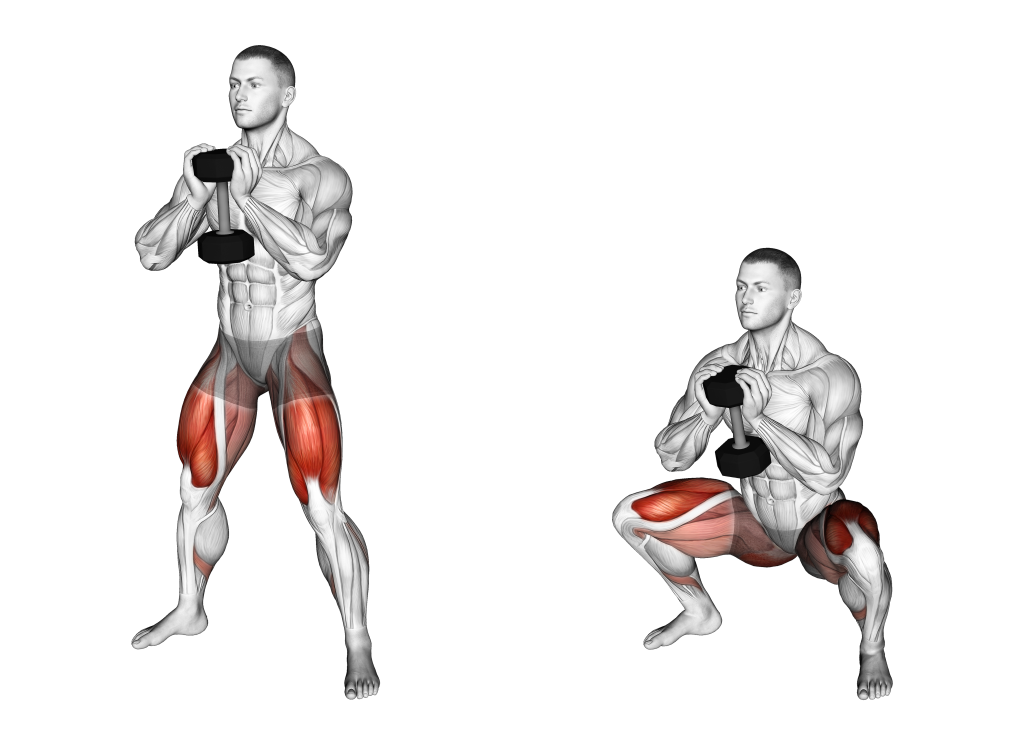
In this stance, the lifter will sit back with their hips, bending at the knees and bracing the core so as to keep the torso as vertical as possible.
Once the thighs are parallel to the floor, the lifter then drives through their heels and rises back to a standing position - taking care not to allow the knees to bend inwards excessively.
With the lifter back in an upright position, the repetition may be considered complete.
4. The Goblet Box Squat
Box squats are simply conventional squats performed with a box or bench being placed behind the lifter.
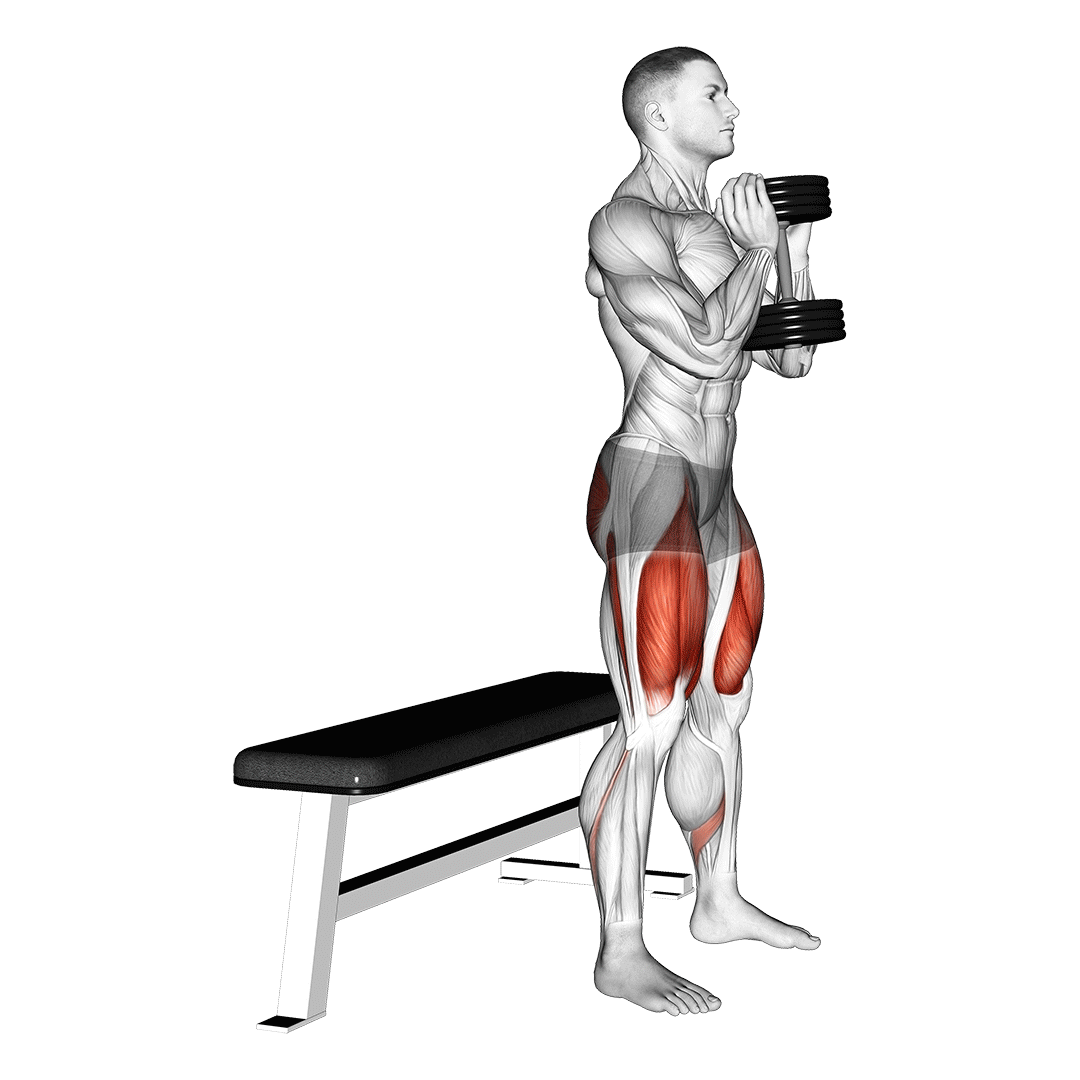
The main purpose behind conventional box squats is two-fold - both correcting issues relating to squat depth, as well as arresting the lifter’s downward momentum so as to force them to rise explosively upwards.
The goblet squat variation of this exercise is no different, as it also features a platform with which the lifter will sit atop as they perform an ordinary squat.
Not only does this allow for many of the benefits of regular box squats to be kept, but it also greatly reduces the spinal loading and risk of injury that is occasionally a complaint of non-goblet box squat variations.
Muscles Worked
Depending on the height of the box used, the posterior chain may or may not play a greater role than the quadriceps femoris.
Generally, the lower the box, the more the glutes and hamstrings will need to be explosively contracted to stand up.
Defining Benefits as a Variation of Goblet Squat
As mentioned previously, the goblet box squat develops lower body explosiveness and aids in fundamental squat movement by correcting the lifter’s squatting depth.
However, apart from these two advantages, the goblet box squat can also be used as a method of progression for lifters who cannot follow standard linear weight progression.
To do so, simply pick an elevation that is challenging to reach, and continue to lower it over the course of several training sessions.
How-to:
In order to perform a repetition of the goblet box squat, the lifter will first select a platform that is at the same elevation as their squat sticking point or weak point. If simply performing the exercise for developing explosiveness, set the box just above parallel depth.
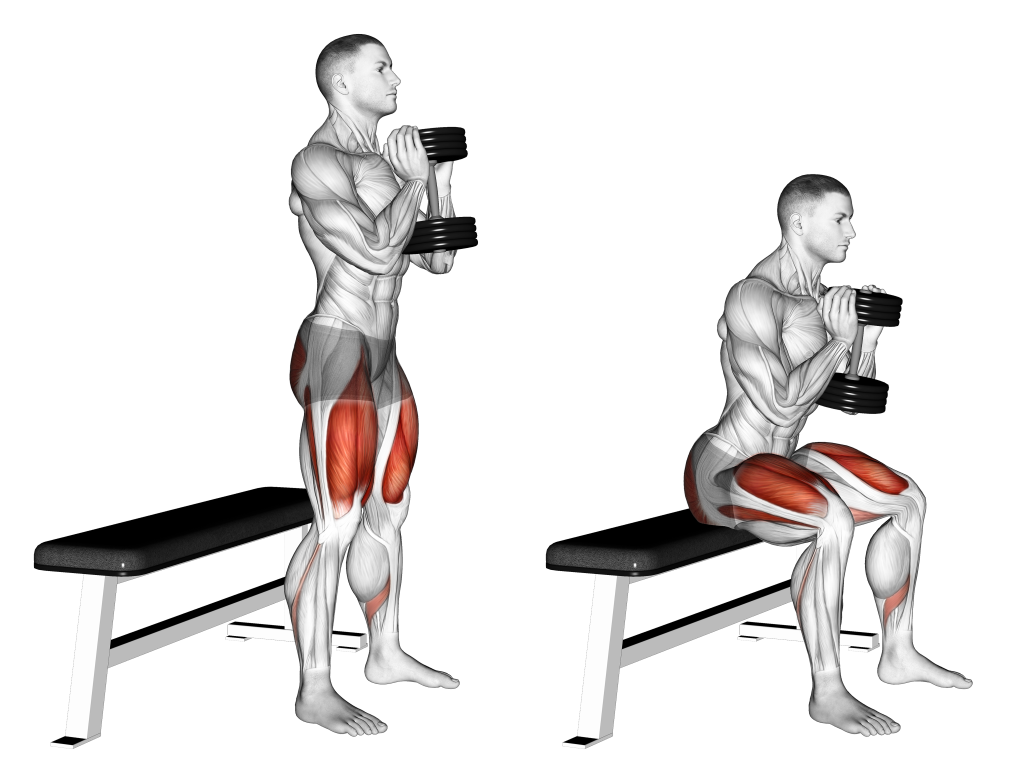
Facing away from the box with a dumbbell or kettlebell held at chest height, the lifter will then sit back as they bend their knees, leading with the glutes until they land atop the box.
5. The Kettlebell Swing to Goblet Squat/Kettlebell Squat Swings
Kettlebell swings and goblet squats are both exercises that are most efficient with the use of a kettlebell.
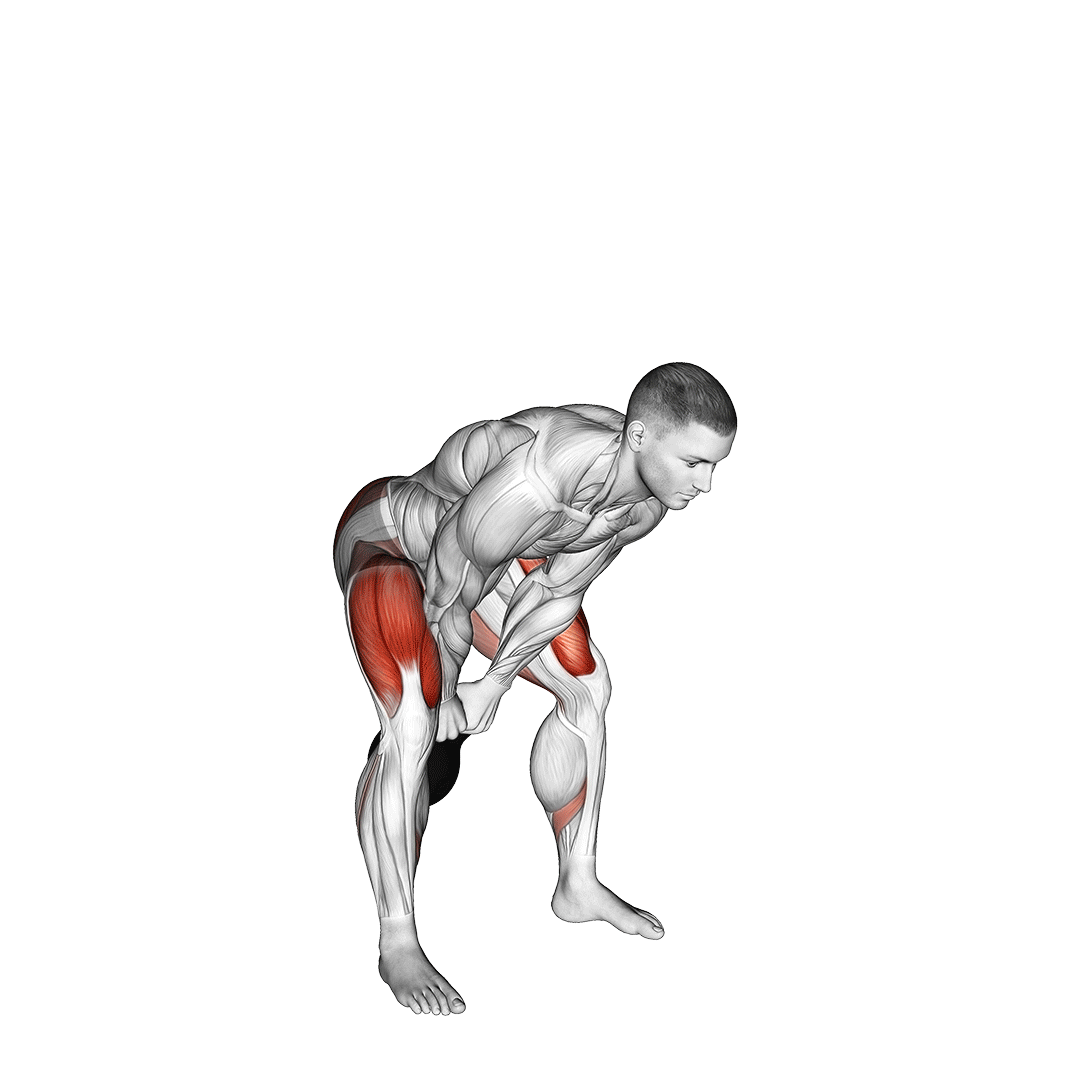
This synergy can be taken even further by combining the two exercises, producing a highly dynamic movement that builds muscle throughout the lower body, back and shoulders.
Kettlebell squat swings are somewhat more complex than either the kettlebell swing or goblet squat, and as such may be better reserved for more advanced athletes - or performed with a low amount of weight.
Muscles Worked
Kettlebell swing to goblet squats will primarily work the glutes and quadriceps, but also target the hamstrings, trapezius, anterior and medial deltoids as well as the serratus anterior.
Defining Benefits as a Variation of Goblet Squat
This particular goblet squat variation builds explosiveness, power and general athleticism throughout the entire body - hence its inclusion into many athletic training protocols.
Apart from the more physical benefits it offers, the kettlebell squat swing is also excellent for improving hip drive in conventional back squats or other lower body exercises.
How-to:
To perform a kettlebell swing to goblet squat, the lifter begins by first performing a kettlebell swing.

This is done by setting the feet around shoulder-width apart, gripping a kettlebell by its handle in both hands and hinging at the hips until the kettlebell is resting beneath the pelvis.
From this stance, the lifter then rapidly pushes their hips forwards and raises the kettlebell upwards, swinging it until it is parallel to the chest as the lifter is in a standing position.
Once the swing has been completed, the lifter then performs the goblet squat portion of the movement by bringing the kettlebell up to chest level, drawing their elbows up from the end of the swing exercise and bracing their core.
Now in the goblet squat stance, the lifter pushes their pelvis back once more and bends at the knees - lowering themselves to parallel depth and completing the repetition.
6. The Goblet Bulgarian Split Squat
Goblet Bulgarian split squats are both a goblet squat and split squat variation that takes the benefits of both to achieve a unique training stimulus.
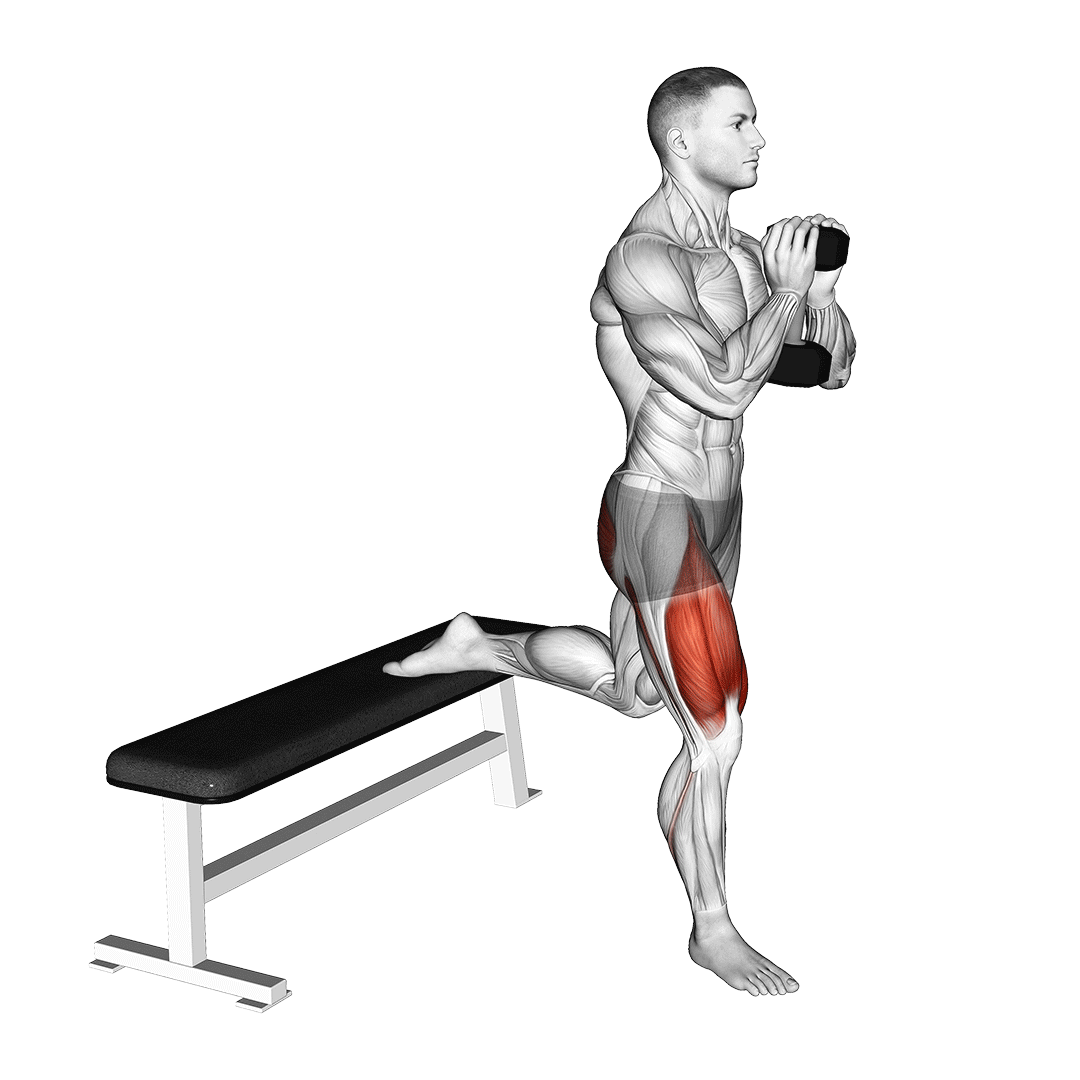
While regular dumbbell or kettlebell Bulgarian split squats will hold the weights at the sides of the body, gripping it in a goblet style will help challenge the stabilizer muscles and aid in achieving proper depth.
Much like conventional Bulgarian split squats, the goblet variation is performed with one leg elevated behind the body and the other extended forwards, creating a unilateral movement pattern reminiscent of a lunge.
Muscles Worked
Goblet Bulgarian split squats prioritize the quadriceps, but also target the glutes and hamstrings to a lesser extent.
Defining Benefits as a Variation of Goblet Squat
Like most other types of split squat, the goblet Bulgarian split squat is excellent for emphasizing the muscles of one leg at a time. This is further reinforced by the fact that much of the body’s weight is shifted to one foot, demanding greater isometric contraction and attention paid to form.
How-to:
To perform a repetition of the goblet Bulgarian split squat, the lifter will begin by hoisting a dumbbell or kettlebell up to chest height, facing away from a bench and setting one foot atop it behind them. This should create a semi-kneeling stance, with much of the body’s weight on the forefoot.
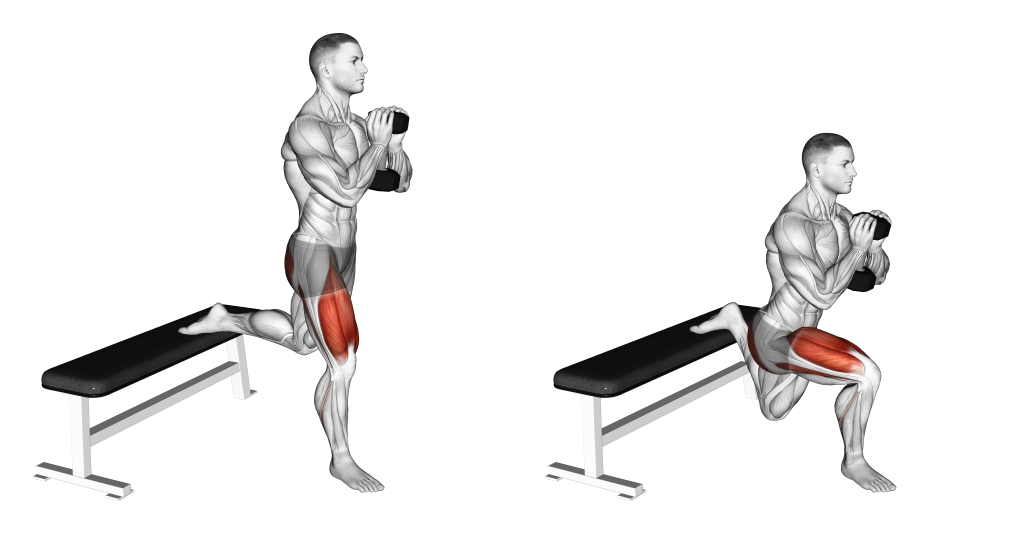
From this stance, the lifter will bend both knees downwards, keeping their torso vertical until the back knee is at a 90 degree angle of flexion.
Once reaching the correct depth, the lifter drives through their forefoot and extends their knees back up - thereby completing the repetition. Don’t forget to repeat the exercise with the sides switched.
Which Goblet Squat Should You Pick?
Though we’ve listed the best goblet squat variations in this article, keep in mind that we haven’t listed every variation. If your needs are more specific than those addressed here, there is likely a more suitable variation out there for you.
However, if you’re simply having trouble picking the right variation, we suggest first mastering conventional goblet squats before moving on to more intense variations.
Exercises like the kettlebell swing squat or Bulgarian split squat are both considerably more challenging, and should only be picked once you have a solid grasp of proper form under your belt.
References
1. Brown, Jason. Lower Body Training: The Definitive Guide to Increasing Size, Strength, and Athletic Performance. United States: Human Kinetics, 2022. ISBN: 9781718206878, 1718206879
2. Lorenzetti S, Ostermann M, Zeidler F, Zimmer P, Jentsch L, List R, Taylor WR, Schellenberg F. How to squat? Effects of various stance widths, foot placement angles and level of experience on knee, hip and trunk motion and loading. BMC Sports Sci Med Rehabil. 2018 Jul 17;10:14. doi: 10.1186/s13102-018-0103-7. Erratum in: BMC Sports Sci Med Rehabil. 2020 Jan 29;12:7. PMID: 30026952; PMCID: PMC6050697.
